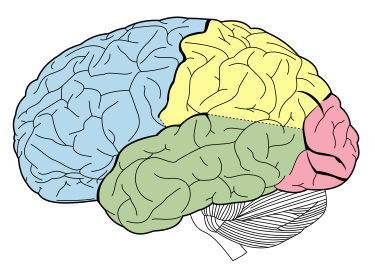As observed in other neurodegenerative conditions, mixed pathologies also exist in ALS. In similar fashion to TDP-43 pathology playing a role in Alzheimer disease, Shuangwu Liu, Chuanzhu Yan and colleagues suggest here that Alzheimer disease pathology also plays a role in ALS. Indeed they found alterations at early stage in the subiculum, which is located in the temporal lobe of the brain, a region different from the frontal lobe which hosts the motor cortex which is classically implicated in ALS.
 Source: Wikipedia. The temporal lobe is shown in green, while the motor area is in the frontal lobe in blue
Source: Wikipedia. The temporal lobe is shown in green, while the motor area is in the frontal lobe in blue
ALS is now considered a multisystemic disorder in which almost half of patients present with varying degrees of cognitive deficits, yet unfolded TDP-43 aggregates in cytosol are found in most ALS cases.
TDP-43 pathology in ALS can be divided into four stages (Braak stages): it begins focally, and then spreads persistently in sequential and regional patterns that typically originate from the motor cortex and extend to the prefrontal cortex, thalamus and eventually, the hippocampus.
However neuroimaging studies of hippocampal volumes in patients with amyotrophic lateral sclerosis (ALS) have reported inconsistent results. The group of Chinese scientists from 10 institutions, aimed to demonstrate that such discrepancies are largely due to atrophy of different regions of the hippocampus that emerge in different disease stages of ALS and to explore the existence of co-pathology in ALS patients.
They used King’s clinical staging system for ALS to classify patients into different disease stages. The scientists then investigated in vivo hippocampal atrophy patterns across subfields and anterior-posterior segments in different King’s stages using structural MRI in 76 ALS patients and 94 health controls.
The thalamus, corticostriatal tract and perforant path were used as structural controls to compare the sequence of alterations between these structures and the hippocampal subfields.
In summary:
- ALS patients at King’s stage 1, had lower volumes in the bilateral posterior subiculum and presubiculum;
- ALS patients at King’s stage 2 exhibited lower volumes in the bilateral posterior subiculum, left anterior presubiculum and left global hippocampus;
- ALS patients at King’s stage 3 showed significantly lower volumes in the bilateral posterior subiculum, dentate gyrus and global hippocampus. Thalamic atrophy emerged at King’s stage 3.
White matter tracts remained normal in a subset of ALS patients.
In the present study, the authors demonstrated that the earliest hippocampal alterations in ALS patients occurred in the posterior subiculum and presubiculum, and these alterations emerged at King’s stage 1. This indicates that subiculum atrophy occurs earlier and independent of TDP-43 pathology in ALS.
 Hagmann P, Cammoun L, Gigandet X, Meuli R, Honey CJ, et al.
Hagmann P, Cammoun L, Gigandet X, Meuli R, Honey CJ, et al.
Taken together, their data suggest that patients with ALS have additional pathologies that are independent of TDP-43 pathology.
Increasingly, studies have shown that at least 20% of ALS patients present significant Alzheimer disease pathology of both Aβ and tau proteins. Recently, Gómez-Pinedo and colleagues showed that in ALS patients, the amyloid cascade of the amyloid precursor protein is activated in the hippocampus of ALS patients, and cytoplasmic Aβ peptide and pTDP-43 expression levels are moderately correlated.
Thus the motor cortex and subiculum seem to represent two independent centres of ALS during the early stages of the disease, which represent TDP-43 pathology and Alzheimer disease pathology, respectively, and these pathologies may converge as the disease progresses toward advanced stages.
If these findings are confirmed in further studies, they will have a profound effect on the understanding of the aetiology and pathogenic mechanisms underlying ALS and other neurodegenerative diseases.

